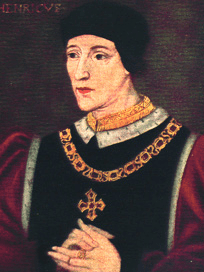
(Wikimedia Commons public domain image)
For me — and, I think, for my wife — the big surprise of the 2019 Utah Shakespeare Festival was the Festival’s production of The Conclusion of Henry VI: Parts Two and Three.
Candidly, I wasn’t really looking forward to this particular play, which is an amalgamation of Shakespeare’s Henry VI: Part II and his Henry VI: Part III. Neither of those plays is very commonly performed — their production in Cedar City this year is part of a deliberate and systematic plan to perform the entire Shakespearean canon — and they’re not commonly performed because they’re not especially crowd-pleasing and because they’re not ranked among Shakespeare’s best works. (Especially Part III.) Moreover, joined together and including the intermission between them, they run about 4.5 hours. That’s getting into Wagnerian-opera territory, and I saw attending them as more duty than pleasure, since I too am interested in completing the whole canon. (Truth be told, because I’ve been attending Shakespearean plays and Shakespeare festivals since the time that the Pacific Plate was about thirteen feet further to the southeast than it is today, I may already have done the entire canon. But I don’t mind making sure, and — it’s Shakespeare, after all — I’m perfectly happy to see these plays multiple times.)
One thing gave me hope, though, and that was the report from Steve Densley that Part II was better than he and his wife had expected and that the 4.5 hours passed by much more easily than they had anticipated.
I found exactly the same thing to be true. The time practically sailed by, and I really enjoyed the performance.
In Shakespeare’s portrayal, Henry VI — who repeatedly expresses his wish that he had never become a king — reminded me of the late Mohammad Reza Pahlavi (1919-1980), the former Shah of Iran, whose daughter I tutored for a year while they were living in exile in Egypt and whom I met and spoke with on one unexpected afternoon. From what I read about him, from what I learned about him from his daughter, and from my impressions of him during our conversation, my sense is that he simply wasn’t cut out to be the leader of a country located in that very, very tough neighborhood. He wasn’t sufficiently ruthless, and I think that he was rather indecisive (just as Shakespeare’s Henry VI is). What decent person wouldn’t be, after all, when virtually every choice is bad?
The situation in which Henry VI finds himself in the plays is absolutely awful. He’s caught, among other things, between his highly intelligent, domineering, and utterly ruthless wife, Margaret of Anjou (whom Shakespeare calls “the she-wolf of France”), the scheming and ambitious Richard of York, and, beginning to make his fateful appearance, Richard’s son — also named Richard — who becomes the third Duke of York and who will then, in the sequel, become King Richard III. One of Shakespeare’s characters refers to this younger Richard in Part II as a “heap of wrath” and, because of his physical deformity, as a “foul undigested lump”).
Some of the scenes in which the English inner circle plot to depose or manipulate the king — and to do each other in, as well — strongly reminded me of certain academic conspiracies I’ve known.
Of course, Shakespeare’s historical plays should not be taken as objective history. Whether inadvertently or by conscious intent, he produced propaganda on behalf of the House of Tudor, under whose rule he wrote — and part of the task of Tudor propaganda was to blacken the reputation of the Plantagenets, and particularly of the Plantagenet House of York, whom Henry Tudor (Henry VII) had violently overthrown.
Nowadays, everyone knows that Richard III was an evil king. To a great degree, this perception comes from Shakespeare’s phenomenal success in portraying him as such. He may be the playwright’s greatest villain, and one of the greatest pieces of acting that I’ve ever seen was surely Gary Armagnac’s horrifying portrayal of Richard III in the 1994 Utah Shakespeare Festival of the play by that name. There may, however, be a horrific injustice here: Some argue that Richard III was actually an exceptionally good king, and there is some evidence that he was unusually popular among the common people and that he was long mourned after his 1485 death in the Battle of Bosworth Field against the forces of Henry Tudor.











